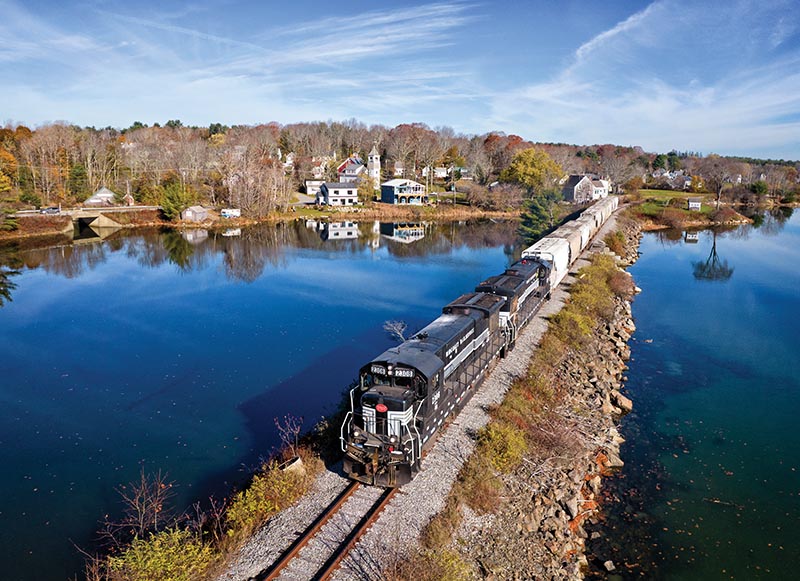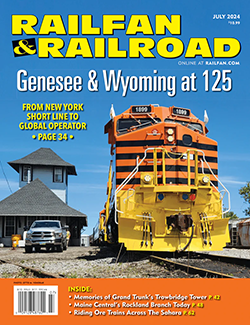 by Justin Franz/photos as noted
by Justin Franz/photos as noted
Change is the only constant. It’s an oft-repeated expression in life and railroading. So often it borders on cliché. But it is an apt turn of phrase to describe the last four decades on Maine’s scenic Rockland Branch, a former Maine Central Railroad route between Rockland and Brunswick. Over the last 40 years, this scenic line has had seven different operators, the longest lasting just 11 years.
Among railroad enthusiasts, the Rockland Branch is considered one of the most iconic sections of the former MEC, perhaps only outshined by the famed Mountain Division. For 56 miles, the railroad skirts along marshes and tidal flats, over ancient drawbridges, and through picturesque villages. It is quintessential Maine.
Yet despite its pastoral setting, railroading in these parts has never been for the faint of heart. It’s a lesson the most recent operator, Midcoast Railservice (a subsidiary of New York’s Finger Lakes Railway) has found out the hard way following the loss of the branch’s largest customer. It’s just the latest twist in a saga that goes back 175 years when the first stretch of track was put down in these parts.
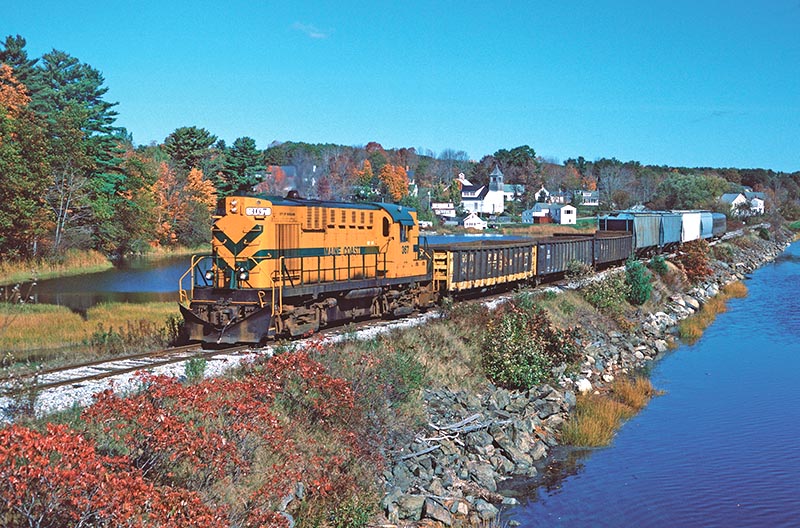
ABOVE: On October 14, 1993, Maine Coast RS-11 367 (ex-Norfolk & Western and Central Vermont) leads a westbound over the causeway at Damariscotta Mills. The empty gondolas up front were previously loaded with iron concentrate for a specialized cement being produced at Dragon Cement in Thomaston. Timothy Franz climbed a large pine tree for this view. —Timothy Franz photo
Building the Rockland Branch
The first section of what would become the Rockland Branch opened for business on July 5, 1849, when the Kennebec & Portland Railroad completed a branch to the west bank of the Kennebec River in Bath from its main line in Brunswick. K&P was chartered in 1836 to construct a route from Portland to the state capital of Augusta, but an eight-mile branch to Bath was a logical addition considering the town’s importance as a shipbuilding hub. Located 10 miles north of the mouth of the river down on the coast, Bath was an ideal place for shipbuilding because it was close to the Atlantic but also protected from storms. The first ship was built in the area in 1607, and at one point about 25 percent of all wooden ships built in the U.S. came from one of Bath’s 22 shipyards.
The same year K&P arrived on the west side of the river, a charter was granted by the state to build a railroad from the Kennebec River to Rockland. Where exactly on the Kennebec River was up for debate, though, as the state said it could be anywhere between Richmond and Bath on the west bank (both communities were served by K&P). Proponents for Richmond argued that their town, farther upriver, would provide an easier crossing of the Kennebec for the railroad. But the town of Bath was more enthusiastic with its support, offering the railroad $600,000 to make it the terminus. Richmond offered $150,000 for the honor, and Bath won. With that decision made, construction of the Knox & Lincoln Railroad began. Building a railroad along Maine’s coast would be no easy feat, particularly because of the hard bedrock the builders had to blast through and the numerous bridges that needed to be constructed. As one surveyor later wrote, “When we came to a river, we bridged it; when we came to a ledge, we blasted it; when we came to a cow, we went around it.”
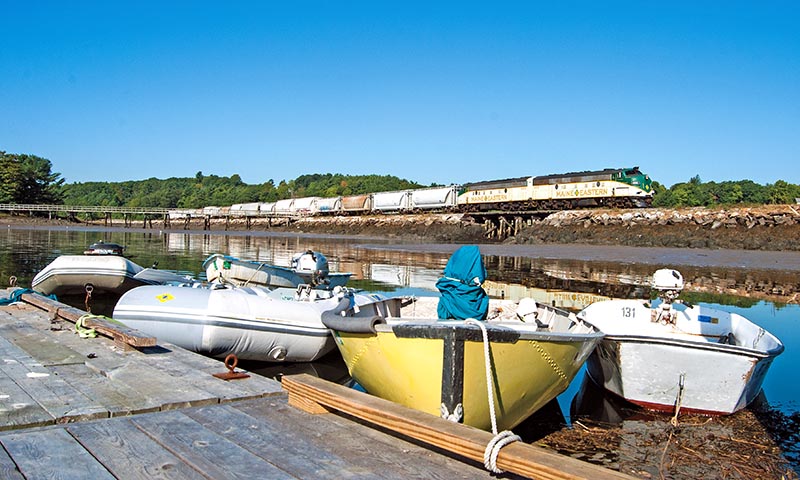
ABOVE: After arriving in 2005, Maine Eastern’s FL9s 488 and 489 were used almost exclusively for passenger service. September 18, 2015, would be a rare exception to that rule, as they pass a dock in Wiscasset with freight. —Dan Nelson photo
It would take more than 20 years to build the railroad from the Kennebec River to Rockland, but it finally opened on October 31, 1871. However, the line was still not connected to the rest of the national rail network and trains had to be floated across the Kennebec from Bath to Woolwich by a car ferry. That continued until October 1927, when a bridge was finally built.
The K&P on the west side of the river would eventually be purchased in the 1870s by Maine Central, which had been created in 1862 through the acquisition of two other railroads. The K&L on the east side of the river would remain independent until 1890, when the debts from its construction finally caught up with it and it was purchased by Penobscot Shore Line Railroad Company. The new owners changed the name of the line to Knox & Lincoln Railway, but after just seven months leased it to MEC. In 1901, MEC outright purchased the line, finally uniting the railroad from Brunswick to Rockland under one owner.
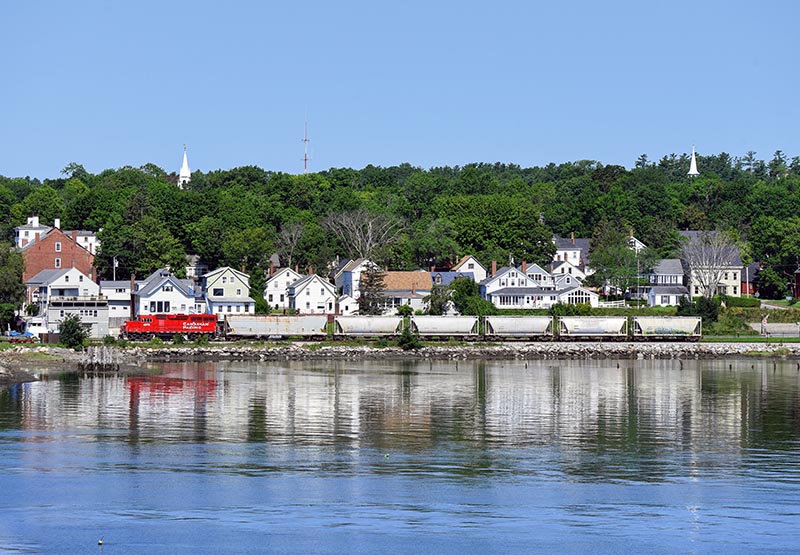
ABOVE: In a postcard-perfect scene that would have been inconceivable just a few years prior, Canadian Pacific GP20C-ECO 2279 skirts along the Sheepscot River at Wiscasset with Train F17 en route to Brunswick on July 24, 2021. CP operated the branch from 2020 until 2022. —Tim Hairston photo
During the early 20th century, the Rockland Branch was a busy route for both freight and passenger trains — so busy, in fact, that by 1910 an automatic block signal system was installed. Two of the biggest customers on the line included Bath Iron Works, which built ships for the U.S. Navy (and still does today), and a cement plant in Thomaston.
Passenger service was especially busy in the summer when people took the train to Maine for vacation. Prior to World War II, it was common for sleeping cars to run through to Rockland from Philadelphia, New York City, and elsewhere. During the postwar boom when the private automobile became the preferred method of travel, nearby U.S. Route 1 began to take a bite out of MEC’s passenger traffic; on April 4, 1959, it ran the last regularly scheduled passenger train to Rockland.
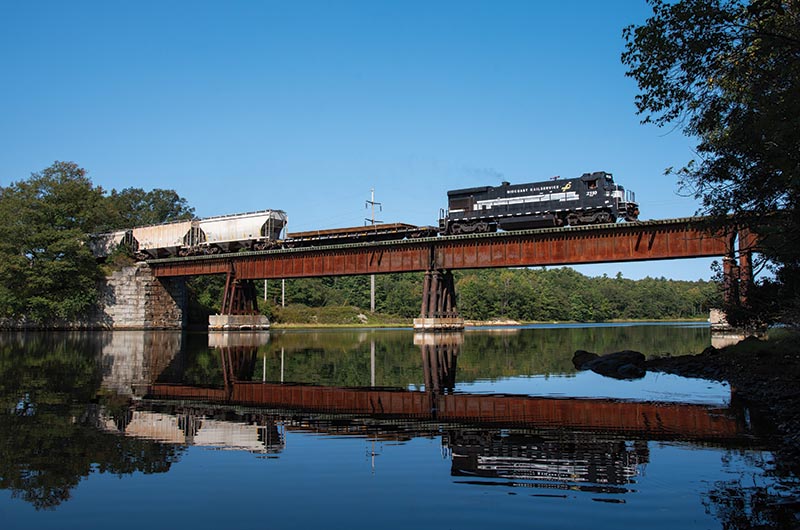
ABOVE: The crystal clear morning of September 22, 2023, finds Finger Lakes B23-7 2310 crossing the New Meadows River from Brunswick into West Bath with a short train. The headpin car is a load of plate steel for Bath Iron Works that will be spotted just east of here at American Steel & Aluminum. —Tim Hairston photo
Freight traffic on the line would remain steady into the 1980s, but the temporary closure and later sale of the cement plant in Thomaston heralded the end of MEC’s Rockland Branch ownership. In 1985, MEC (by then part of Guilford Transportation Industries) filed to abandon the line, and in 1986 the last local out of Rigby Yard in South Portland made its weekly run up the coast; the few customers that remained on the line began to ship their freight via highway. In 1987, Guilford sold the line to the Maine Department of Transportation…


